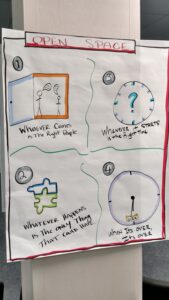
“One of the people I manage is underperforming. I need to give them feedback about how they aren’t meeting expectations.”
I hear this often from managers, and I get curious whenever I do. The instinct behind it is good: Managers need to address underperformance. In my experience, however, giving performance feedback about unmet expectations is unlikely to help if you haven’t done your homework first. One of my teachers says, “80% of employee problems are due to manager neglect.” Whether you are a manager or not, when someone isn’t meeting your expectations, start by looking at what you’re doing – and what you’re not.



 Conflict is a challenging topic for many people to navigate. It’s a natural part of working together in groups, yet in the midst of it, it can feel terribly dysfunctional. There’s no shortage of ideas about how to work through it, and t
Conflict is a challenging topic for many people to navigate. It’s a natural part of working together in groups, yet in the midst of it, it can feel terribly dysfunctional. There’s no shortage of ideas about how to work through it, and t
 “We don’t have time for a retrospective. We have ‘real work’ to do.”
“We don’t have time for a retrospective. We have ‘real work’ to do.”
 Some of my most spectacular failures working with teams have come from going deeper than I needed to. One particularly memorable retrospective ended with a product manager declaring, “I’m done talking about my feelings.” (It was not my finest moment.) Yes, organizations are made of people. And yes, work happens inside a container of relationships. But that doesn’t mean every attempt to address a team or organizational problem must be super deep. Choosing the depth at which to intervene is critical for every manager, consultant, and coach.
Some of my most spectacular failures working with teams have come from going deeper than I needed to. One particularly memorable retrospective ended with a product manager declaring, “I’m done talking about my feelings.” (It was not my finest moment.) Yes, organizations are made of people. And yes, work happens inside a container of relationships. But that doesn’t mean every attempt to address a team or organizational problem must be super deep. Choosing the depth at which to intervene is critical for every manager, consultant, and coach. Open Space was inspired by the hallway conversations that occurred at traditional conferences. Open Space needs people who will propose and host sessions. The question is: if you’re attending an Open Space event, should YOU host a session?
Open Space was inspired by the hallway conversations that occurred at traditional conferences. Open Space needs people who will propose and host sessions. The question is: if you’re attending an Open Space event, should YOU host a session?
 “I don’t understand products vs. projects. What’s the difference?”
“I don’t understand products vs. projects. What’s the difference?”




 “I don’t want to distract the team. They don’t need to worry about this.” That’s what my boss – the head of engineering at a rapidly growing startup – told me when I asked him how he would share information from top management about our revised expansion plans. His job, he said, was to protect the engineers from things like this and to let them focus on building the product.
“I don’t want to distract the team. They don’t need to worry about this.” That’s what my boss – the head of engineering at a rapidly growing startup – told me when I asked him how he would share information from top management about our revised expansion plans. His job, he said, was to protect the engineers from things like this and to let them focus on building the product.